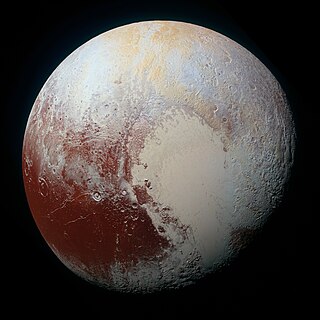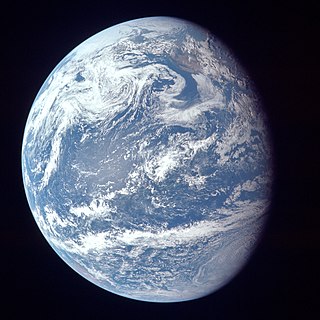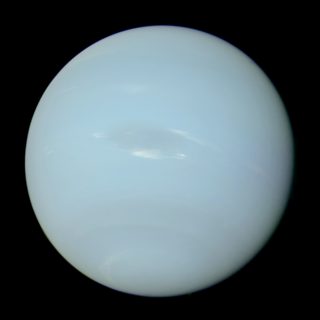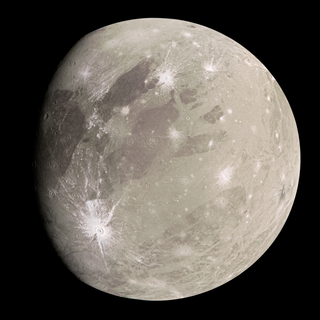Related Research Articles

Triton is the largest natural satellite of the planet Neptune. It is the only moon of Neptune massive enough to be rounded under its own gravity and hosts a thin but well-structured atmosphere. Triton orbits Neptune in a retrograde orbit—an orbit in the direction opposite to its planet's rotation—the only large moon in the Solar System to do so. Triton is thought to have once been a dwarf planet, captured from the Kuiper belt into Neptune orbit.

Pluto is a dwarf planet in the Kuiper belt, a ring of bodies beyond the orbit of Neptune. It is the ninth-largest and tenth-most-massive known object to directly orbit the Sun. It is the largest known trans-Neptunian object by volume, by a small margin, but is less massive than Eris. Like other Kuiper belt objects, Pluto is made primarily of ice and rock and is much smaller than the inner planets. Pluto has roughly one-sixth the mass of Earth's moon, and one-third its volume.

Rhea is the second-largest moon of Saturn and the ninth-largest moon in the Solar System, with a surface area that is comparable to the area of Australia. It is the smallest body in the Solar System for which precise measurements have confirmed a shape consistent with hydrostatic equilibrium. It was discovered in 1672 by Giovanni Domenico Cassini.

Sandra Moore Faber is an American astrophysicist known for her research on the evolution of galaxies. She is the University Professor of Astronomy and Astrophysics at the University of California, Santa Cruz, and works at the Lick Observatory. She has made discoveries linking the brightness of galaxies to the speed of stars within them and was the co-discoverer of the Faber–Jackson relation. Faber was also instrumental in designing the Keck telescopes in Hawaii.

The geology of Pluto consists of the characteristics of the surface, crust, and interior of Pluto. Because of Pluto's distance from Earth, in-depth study from Earth is difficult. Many details about Pluto remained unknown until 14 July 2015, when New Horizons flew through the Pluto system and began transmitting data back to Earth. When it did, Pluto was found to have remarkable geologic diversity, with New Horizons team member Jeff Moore saying that it "is every bit as complex as that of Mars". The final New Horizons Pluto data transmission was received on 25 October 2016. In June 2020, astronomers reported evidence that Pluto may have had a subsurface ocean, and consequently may have been habitable, when it was first formed.

An ocean world, ocean planet or water world is a type of planet that contains a substantial amount of water in the form of oceans, as part of its hydrosphere, either beneath the surface, as subsurface oceans, or on the surface, potentially submerging all dry land. The term ocean world is also used sometimes for astronomical bodies with an ocean composed of a different fluid or thalassogen, such as lava, ammonia or hydrocarbons. The study of extraterrestrial oceans is referred to as planetary oceanography.

Neptune is the eighth and farthest known planet from the Sun. It is the fourth-largest planet in the Solar System by diameter, the third-most-massive planet, and the densest giant planet. It is 17 times the mass of Earth, and slightly more massive than fellow ice giant Uranus. Neptune is denser and physically smaller than Uranus because its greater mass causes more gravitational compression of its atmosphere. Being composed primarily of gases and liquids, it has no well-defined solid surface. The planet orbits the Sun once every 164.8 years at an orbital distance of 30.1 astronomical units. It is named after the Roman god of the sea and has the astronomical symbol , representing Neptune's trident.

An ice planet or icy planet is a type of planet with an icy surface of volatiles such as water, ammonia, and methane. Ice planets consist of a global cryosphere.
Sarah Dodson-Robinson is an American astronomer known for her work on planet formation and an associate professor of physics and astronomy at the University of Delaware.

The Nexus for Exoplanet System Science (NExSS) initiative is a National Aeronautics and Space Administration (NASA) virtual institute designed to foster interdisciplinary collaboration in the search for life on exoplanets. Led by the Ames Research Center, the NASA Exoplanet Science Institute, and the Goddard Institute for Space Studies, NExSS will help organize the search for life on exoplanets from participating research teams and acquire new knowledge about exoplanets and extrasolar planetary systems.
Victoria Suzanne Meadows is a Professor with the Astronomy Department and Director of the Astrobiology Program at the University of Washington. She is also the Principal Investigator for the NASA Astrobiology Institute's Virtual Planetary Laboratory Lead Team and the chair of the NAI Focus Group on Habitability and Astronomical Biosignatures (HAB). The research direction of the team is to create computer models that can be used to understand planet formation, stability and orbital evolution, and to simulate the environment and spectra of planets that can potentially be habitable.
Bonnie J. Buratti is an American planetary scientist in the Division of Earth and Space Sciences at the Jet Propulsion Laboratory in Pasadena, California, where she leads the Comets, Asteroids, and Satellites Group. Her research involves the composition and physical properties of planetary surfaces, and volatile transport in the outer solar system.
Linda Spilker is an American planetary scientist who served as the project scientist for the Cassini mission exploring the planet Saturn. Her research interests include the evolution and dynamics of Saturn's rings. She is presently the Project Scientist for the Voyager missions.
Nadia Drake is an American science journalist and is the interim Physics Editor at Quanta Magazine. Previously, she was a contributing writer at National Geographic.

Jani Radebaugh is an American planetary scientist and professor of geology at Brigham Young University who specializes in field studies of planets. Radebaugh's research focuses on Saturn's moon Titan, Jupiter's moon Io, the Earth's Moon, Mars and Pluto. Radebaugh is a Science Team member of the Dragonfly mission to Titan, the IVO Io mission proposal, and the Mars Median project. She was an Associate Team Member of the Cassini-Huygens RADAR instrument from 2008 to 2017, and was a graduate student scientist for Io for the Galileo mission. She does science outreach through her work as an expert contributor to the Science/Discovery program How the Universe Works and other television and radio programs. In December 2012, Radebaugh and her colleagues on the Cassini mission announced the discovery of Vid Flumina, a liquid methane river on Saturn's moon Titan over 320 km (200 mi) long and resembling the Nile river.

Carrie Anderson is an American planetary scientist at NASA's Goddard Space Flight Center.
Melissa McGrath is an astronomer whose expertise is the atmosphere and magnetosphere of the Solar System planets and their moons. Her main interest has focused on imaging and spectroscopic studies of Jupiter’s Galilean moons. She is currently co-investigator on the ultraviolet spectrometer instrument on ESA JUICE mission to Ganymede, and co-investigator on two proposed instruments on the NASA Europa Clipper mission. McGrath is senior scientist at SETI Institute in Mountain View, California.
Cynthia B. Phillips is an American planetary geologist who works for NASA at the Jet Propulsion Laboratory. A focus of her research has been Europa, one of the moons of Jupiter, and she is project staff scientist and project science communications lead for the Europa Clipper spacecraft mission. An expert on processing images from space missions to the planets and their moons, and on the geological processes operating within moons, she has studied the effects of asteroid impacts on the surface of Europa, and definitions of non-earth-based life that could apply on places like Europa that are outside the circumstellar habitable zone.
Amanda Bosh is an American planetary scientist and observational astronomer best known for her work on small solar system objects. She is the chief operating officer at Lowell Observatory in Flagstaff, Arizona. and is involved which the Lowell Observatory Native American Outreach program, which she co-founded.
References
- 1 2 "151351 Dalleore (2002 CS282)", JPL Small-Body Database, retrieved 2024-05-05; "25945 Moreadalleore (2001 EQ10)", JPL Small-Body Database, retrieved 2024-05-05
- 1 2 3 4 Chioda, Eleonora (May 14, 2023), "Cristina Dalle Ore: dalle stelle alle stalle, per risolvere i problemi dell'umanità", la Repubblica (in Italian), retrieved 2024-05-05
- 1 2 "Cristina Dalle Ore", Speaker Biography, SMAU 2023, retrieved 2024-05-05
- ↑ "Cristina Dalle Ore", Our scientists, SETI Institute, retrieved 2024-05-05
- ↑ Haynes, Korey (May 30, 2019), "Ammonia on Pluto's surface points to liquid water underground", Discover, retrieved 2024-05-05
- ↑ Simonetti, Silvia (August 22, 2015), "Cristina Dalle Ore: The Nasa scientist from Treviso who took part in the New Horizons mission", L'Italo Americano, retrieved 2024-05-05
- 1 2 Curriculum vitae (PDF), SETI Institute, 2010, retrieved 2024-05-05
- ↑ "Cristina Morea Dalle Ore", AstroGen, American Astronomical Society, retrieved 2024-05-05